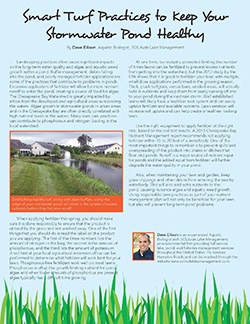Smart Turf Practices to Keep Your Stormwater Pond Healthy
September 26th, 2016
AS SEEN IN Currents, a publication of the Southeast Virginia Chapter, Community Associations Institute: Written by Industry Expert, Dave Ellison, Regional Director & Aquatic Biologist
 Landscaping practices often cause significant impacts on the long-term water quality and algae and aquatic weed growth within a pond. Buffer management, debris falling into the pond, and poorly managed fertilizer applications are some of the practices that contribute to problems in ponds. Excessive application of fertilizer will allow for more nutrient runoff to enter the pond, creating a source of food for algae.
Landscaping practices often cause significant impacts on the long-term water quality and algae and aquatic weed growth within a pond. Buffer management, debris falling into the pond, and poorly managed fertilizer applications are some of the practices that contribute to problems in ponds. Excessive application of fertilizer will allow for more nutrient runoff to enter the pond, creating a source of food for algae.
The Chesapeake Bay Watershed is greatly impacted by inflow from the developed and agricultural areas surrounding the waters. Algae growth in stormwater ponds in urban areas and in the Chesapeake Bay are often directly correlated with high nutrient levels in the waters. Many lawn care practices can contribute to phosphorous and nitrogen loading in the local watershed.
When applying fertilizer, you should make sure it is done responsibly to ensure that the product is utilized by the grass and not washed away. One of the first things that you should do is read the label on the product you are applying. The first of the three numbers lists the amount of nitrogen in the bag, the second is the amount of phosphorous, and the third lists the amount of potassium. A soil test at your local agricultural extension office can be performed to determine what fertilizer will work best for your lawn. Phosphorous-free fertilizers work well on most lawns. Phosphorous is often the growth limiting nutrient for pond algae and when lower amounts of phosphorous are present, algae typically has a difficult time growing.
At one time, our industry promoted limiting the number of times lawns can be fertilized to prevent excess nutrients from getting into the watershed, but the 2013 study by the EPA shows that it is good to fertilizer your lawn with multiple, small dose applications performed in the growing season. Thick, plush turfgrass, versus bare, eroded areas, will actually hold in nutrients and keep them from easily running off into to your pond during the next rain storm. Well established lawns will likely have a healthier root system and can easily uptake fertilizer and available nutrients. Lawn aeration will increase soil uptake and can help create a healthier looking lawn.
Use the right equipment to apply fertilizer at the right rate, based on the soil test results. A 2013 Chesapeake Bay Nutrient Management report recommends not applying fertilizer within 15 to 20 feet of a waterbody. One of the most important things to remember is to prevent spills and overspreading of the product into drains or ditches that flow into ponds. Runoff is a major source of nutrient input for ponds and the added input from fertilizer will further degrade the water quality in your pond.
Also, when maintaining your lawn and garden, keep grass clippings and other debris from entering the nearby waterbody. This will also add extra nutrients to the pond, causing nuisance algae and aquatic weed growth. Using responsible lawn practices as part of your nutrient management plan will not only be beneficial for your lawn, but also will prevent long term pond problems.
Establishing healthy turf, along with plant buffers, along the edge of your stormwater pond will assist in the uptake of excess nutrients before they become runoff.
Contact the experts at 888-480-5253 for all of your lake, pond and fisheries management needs.
 David Ellison is an aquatic biologist with the SOLitude Lake Management team who serves as the regional director for the south. Dave is a certified pesticide applicator for turf, aquatics, and public health in 8 states and is a certified AquaMaster and Aqua Control technician, a SePRO preferred applicator, and a certified stormwater inspector. Dave leads many of SOLitude’s large projects focusing on invasive species control at Chincoteague National Wildlife Refuge, Fisherman’s Island Wildlife Refuge and Ft. Eustis.
David Ellison is an aquatic biologist with the SOLitude Lake Management team who serves as the regional director for the south. Dave is a certified pesticide applicator for turf, aquatics, and public health in 8 states and is a certified AquaMaster and Aqua Control technician, a SePRO preferred applicator, and a certified stormwater inspector. Dave leads many of SOLitude’s large projects focusing on invasive species control at Chincoteague National Wildlife Refuge, Fisherman’s Island Wildlife Refuge and Ft. Eustis.
SOLitude Lake Management is committed to providing full service lake and pond management services that improve water quality, preserve natural resources, and reduce our environmental footprint. Our services include lake, pond and fisheries management programs, algae and aquatic weed control, mechanical harvesting, installation and maintenance of fountains and aeration systems, water quality testing and restoration, bathymetry, lake vegetation studies, biological assessments, habitat assessments, invasive species management and nuisance wildlife management. Lake, pond and fisheries management services, consulting, and aquatic products are available nationwide. Learn more about SOLitude Lake Management and purchase products at www.solitudelakemanagement.com.










